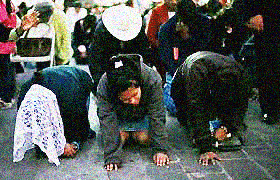 We’re honored to have Michael Busch dissecting the latest WikiLeaks document dump for Focal Points. This is the forty-third in the series.
We’re honored to have Michael Busch dissecting the latest WikiLeaks document dump for Focal Points. This is the forty-third in the series.
Once Latin America’s safest city, Monterrey—in the north of Mexico—has become a central battlefield in the country’s war against drugs. Each day, scores of people, many in law enforcement, are gunned down on Monterrey’s streets as increasingly powerful narcotraffickers contest the Mexican government’s sovereign control over its richest city.
As a US embassy cable published Saturday by WikiLeaks shows, however, the fight between Mexican authorities and the country’s drug gangs is hardly a clear-cut case of good guys taking on the bad.
Written at the start of 2009, the cable examines civil society efforts to combat the rising influence, and attendant violence, of drug traffickers in Monterrey and its immediate surroundings. Diplomats at the local consulate note that
As the wave of kidnappings, extortion, and narco-violence continues in the Monterrey region, the public—across all socioeconomic levels and classes—remains fearful. Attention shifts from one incident to another, whether it be the January 6 grenade attack on the Monterrey Televisa broadcast offices, the January 18 murder of a wealthy adolescent departing a nightclub, or the January 25 dumping of a tortured corpse outside the state government’s anonymous tipster office. Many local experts do not expect the situation to improve anytime soon.
One of those experts, Governor Socrates Rizzo of Nuevo Leon, the state in which Monterrey is located, told American diplomats that a large part of the trouble came from a compromised local government which was ineffectual at best, thoroughly corrupted by drug money at worst. “If citizens are afraid to turn to the authorities when faced with threats,” the cable concludes, “then truly crime victims are on their own.”
Making matters worse, Rizzo openly worried that the national elections slated for July—which dealt a decisive blow to President Felipe Calderon’s ruling PAN party—would draw drug traffickers and organized politics even closer.
While the two principal parties—PRI and PAN—had both taken steps to guard against the infiltration of narco-money in the campaigns, in practice it would be virtually impossible to prevent organized crime from bankrolling candidates. One way the cartels could impact the race would be to just bribe television anchorpersons and commentators, thereby ensuring that their particular candidate would receive favorable coverage. Alternatively…organized crime could provide a candidate’s staff with walking around money to distribute to voters.
Not only that, “applicable campaign finance regulations only cover the candidate, so that it would be easy to simply funnel the narco-money to a family member.”
The prospect of elections also brought to light the scarier prospect that rival politicians might use their connections to organize crime to violently contest for political control. The January 6 attacks on the Televisa headquarters, it turns out, were likely not
a response to any reporting done by that broadcast outlet on the cartels. Instead, [media representatives] saw it as an attempt by organized crime to inflict political damage on the current Nuevo Leon State Secretary for Governance—who happens to be the current governor’s preferred candidate to win the PRI nomination in the gubernatorial race. Under this line of argument, political mafias contracted organized crime gunmen to carry out the attack—if true, an even more chilling scenario [than] the alternative theory that the cartels themselves were behind the assault.
While the Institutional Revolutionary Party (PRI) cleaned up at the polls, violence in Monterrey and across the country has only increased in frequency and magnitude. Local politicians and law enforcement have been particularly under attack. Just this Thursday, an elite squad of police in Garcia—a Monterrey suburb town—was attacked by a team of former police officers working for organized crime. The next day, Jaime Rodriguez—mayor of Garcia—barely survived an assassination attempt as he traveled to Monterrey.
Three mayors nationwide have already been murdered since the start of 2011, and a fourth is currently missing. Nearly 1,200 Mexicans have lost their lives to drug-related violence since January.
